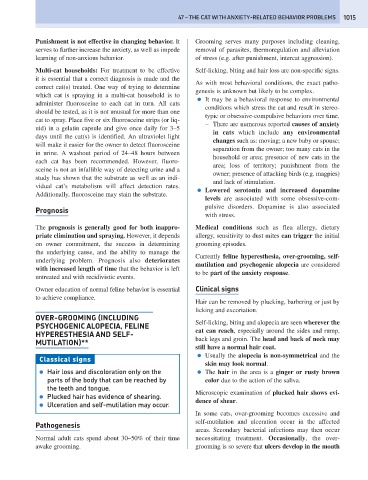Page 1023 - Problem-Based Feline Medicine
P. 1023
47 – THE CAT WITH ANXIETY-RELATED BEHAVIOR PROBLEMS 1015
Punishment is not effective in changing behavior. It Grooming serves many purposes including cleaning,
serves to further increase the anxiety, as well as impede removal of parasites, thermoregulation and alleviation
learning of non-anxious behavior. of stress (e.g. after punishment, intercat aggression).
Multi-cat households: For treatment to be effective Self-licking, biting and hair loss are non-specific signs.
it is essential that a correct diagnosis is made and the
As with most behavioral conditions, the exact patho-
correct cat(s) treated. One way of trying to determine
genesis is unknown but likely to be complex.
which cat is spraying in a multi-cat household is to
● It may be a behavioral response to environmental
administer fluorosceine to each cat in turn. All cats
conditions which stress the cat and result in stereo-
should be tested, as it is not unusual for more than one
typic or obsessive-compulsive behaviors over time.
cat to spray. Place five or six fluorosceine strips (or liq-
– There are numerous reported causes of anxiety
uid) in a gelatin capsule and give once daily for 3–5
in cats which include any environmental
days until the cat(s) is identified. An ultraviolet light
changes such as: moving; a new baby or spouse;
will make it easier for the owner to detect fluorosceine
separation from the owner; too many cats in the
in urine. A washout period of 24–48 hours between
household or area; presence of new cats in the
each cat has been recommended. However, fluoro-
area; loss of territory; punishment from the
sceine is not an infallible way of detecting urine and a
owner; presence of attacking birds (e.g. magpies)
study has shown that the substrate as well as an indi-
and lack of stimulation.
vidual cat’s metabolism will affect detection rates.
● Lowered serotonin and increased dopamine
Additionally, fluorosceine may stain the substrate.
levels are associated with some obsessive-com-
pulsive disorders. Dopamine is also associated
Prognosis
with stress.
The prognosis is generally good for both inappro- Medical conditions such as flea allergy, dietary
priate elimination and spraying. However, it depends allergy, sensitivity to dust mites can trigger the initial
on owner commitment, the success in determining grooming episodes.
the underlying cause, and the ability to manage the
Currently feline hyperesthesia, over-grooming, self-
underlying problem. Prognosis also deteriorates
mutilation and psychogenic alopecia are considered
with increased length of time that the behavior is left
to be part of the anxiety response.
untreated and with recidivistic events.
Owner education of normal feline behavior is essential Clinical signs
to achieve compliance.
Hair can be removed by plucking, barbering or just by
licking and excoriation.
OVER-GROOMING (INCLUDING
PSYCHOGENIC ALOPECIA, FELINE Self-licking, biting and alopecia are seen wherever the
HYPERESTHESIA AND SELF- cat can reach, especially around the sides and rump,
MUTILATION)** back legs and groin. The head and back of neck may
still have a normal hair coat.
● Usually the alopecia is non-symmetrical and the
Classical signs
skin may look normal.
● Hair loss and discoloration only on the ● The hair in the area is a ginger or rusty brown
parts of the body that can be reached by color due to the action of the saliva.
the teeth and tongue.
Microscopic examination of plucked hair shows evi-
● Plucked hair has evidence of shearing.
dence of shear.
● Ulceration and self-mutilation may occur.
In some cats, over-grooming becomes excessive and
self-mutilation and ulceration occur in the affected
Pathogenesis
areas. Secondary bacterial infections may then occur
Normal adult cats spend about 30–50% of their time necessitating treatment. Occasionally, the over-
awake grooming. grooming is so severe that ulcers develop in the mouth

